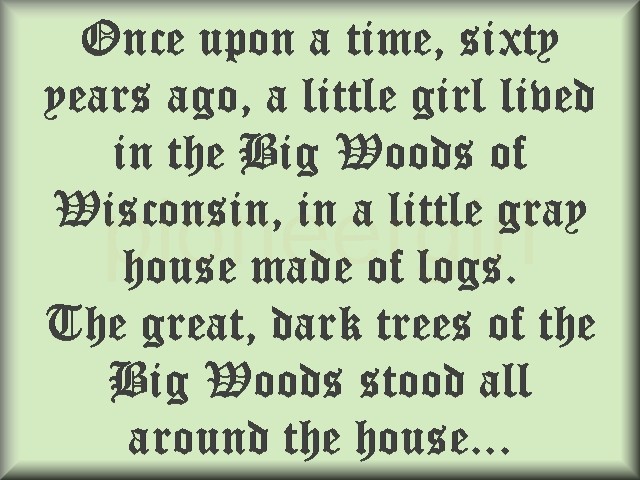Old English letters

One of the varieties of printing types which compose an ordinary book. Besides the Roman and Italic, the most important of the varieties are Old English or Black Letter, German Text, Full-face, Antique, Script, Old Style, and Gothic. — Webster, 1882
 The card was plain and white. Printed on it in Old English letters was, Almanzo James Wilder. – Little Town on the Prairie, Chapter 16, “Name Cards”
The card was plain and white. Printed on it in Old English letters was, Almanzo James Wilder. – Little Town on the Prairie, Chapter 16, “Name Cards”
 In order to receive a teaching certificate, Laura Ingalls was tested in orthography, or spelling. Part of this study was alphaology, or the study of the characters and functions of letters of the alphabet as the elements of literal words. In the English language, the letters in each pair (Aa, Bb, Cc) bear the same name and represent the same sounds, and our English alphabet has twenty-six letters made up of these capital and lower case letters. These letters, in turn, were primarily written or printed – as in the publication of newspapers or books – in three ways. The first was Italic, used to denote emphasis and importance. Such letters are called italic in reference to Italy, the country that first used them. The second was Roman letters, or those letters which have an upright form, called Roman because they were first used in Rome. The third is Old English (see example at right), or letters that have an antique complex form.
In order to receive a teaching certificate, Laura Ingalls was tested in orthography, or spelling. Part of this study was alphaology, or the study of the characters and functions of letters of the alphabet as the elements of literal words. In the English language, the letters in each pair (Aa, Bb, Cc) bear the same name and represent the same sounds, and our English alphabet has twenty-six letters made up of these capital and lower case letters. These letters, in turn, were primarily written or printed – as in the publication of newspapers or books – in three ways. The first was Italic, used to denote emphasis and importance. Such letters are called italic in reference to Italy, the country that first used them. The second was Roman letters, or those letters which have an upright form, called Roman because they were first used in Rome. The third is Old English (see example at right), or letters that have an antique complex form.
Letters can either be printed:  or written:
or written:  , and either
, and either
plain (simple in their structure):  or ornamental (fancy):
or ornamental (fancy):  .
.
 Until the fifteenth century, we used Old English letters in writing, which were the Roman letters, ornamented. After that, plain Roman letters were more in use because with an increase in the numbers of person who could read, and in the availability of the printed page, these were both easier to read and less costly to produce. During the time of the Little House books, printers were limited in the variety of print used because that meant having lead type available in each font and size they wished to use. Although the font of their name cards wasn’t discussed in Little Town on the Prairie (see Chapter 16, “Name Cards”) as much as the style of the card – Minnie Johnson chose a pale blue card and Laura Ingalls decided on one with a spray of roses and cornflowers – Laura’s name is said to appear on her card in “thin, clear type” while Almanzo Wilder’s name is in Old English letters.
Until the fifteenth century, we used Old English letters in writing, which were the Roman letters, ornamented. After that, plain Roman letters were more in use because with an increase in the numbers of person who could read, and in the availability of the printed page, these were both easier to read and less costly to produce. During the time of the Little House books, printers were limited in the variety of print used because that meant having lead type available in each font and size they wished to use. Although the font of their name cards wasn’t discussed in Little Town on the Prairie (see Chapter 16, “Name Cards”) as much as the style of the card – Minnie Johnson chose a pale blue card and Laura Ingalls decided on one with a spray of roses and cornflowers – Laura’s name is said to appear on her card in “thin, clear type” while Almanzo Wilder’s name is in Old English letters.
The English alphabet, in Old English type.


Old English letters (LTP 16), see also name cards, orthography

